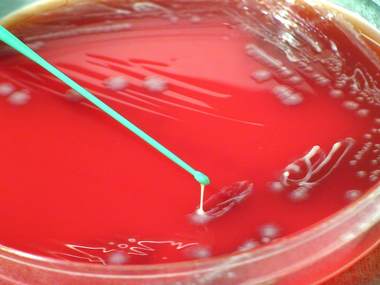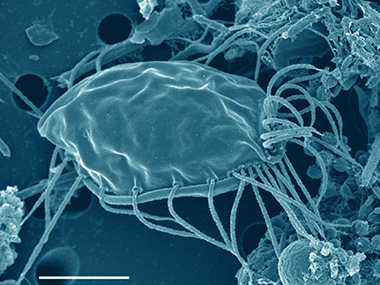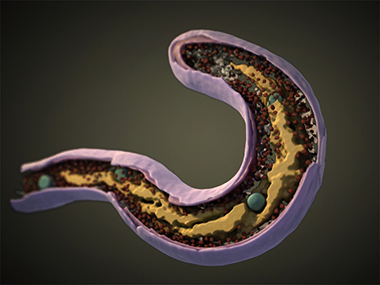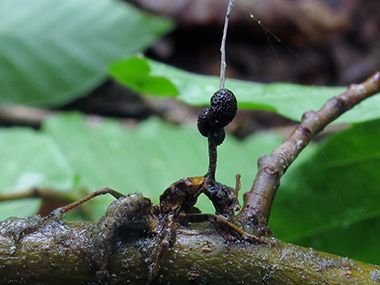Five spooky microbes for Hallowe'en
Hallowe’en is here! Trick or treaters are going out in hordes dressed in costumes of scary monsters, their favourite comic book characters, or whatever could be thrown together last minute because they didn’t have enough time to prepare. There are scary microbes all around us too – though you probably won’t see them trick or treating – so we’ve put together our favourite five to give you nightmares, releasing a new one every day!

Ghouls! Bacteria that produce cadaverine
Starting off less 'terrifying' and more 'just smelly', these ones are actually beneficial to society! Cadaverine is a small molecule that many organisms produce, but is best known for its pungent stench of rotting flesh. Recently, a lot of work has gone into engineering these bacteria – which include Clostridia, Corynebacterium, and E. coli – to produce even more cadaverine. Why would you want to make more of this stuff? Well cadaverine is actually valuable as a monomer for plastics, used to make polyamides. Better still, once made into a polymer, the plastic doesn’t smell at all. On top of that, it has also been shown to have medicinal uses in reducing risk factors for a number of commmon diseases! Not so scary after all!

Vampires! The bacteria which grow on blood
Many clinical microbiologists will be familiar with these organisms – difficult to culture pathogens that will only grow on media known as ‘blood agar’. Blood agar is similar to ‘nutrient agar’, which is used routinely to grow many common bacteria, but has the small but notable difference of being 5% sheep’s blood! Streptococcus is the most well-known genus of bacteria to grow on this medium, where it is used to detect haemolysis (the destruction of red blood cells) in order to categorise different Streptococcus species.

Big Hairy Ogres! Ravenous protists that are still a mystery
A recent addition to the group of protists known as Hemimastigotes, Hemimastix kukwesjijk was named after a Mi’kmaq legend of a ravenous hairy ogre known as ‘Kukwes’. Looking at it under the microscope, you can see how it got its name. This organism is covered in flagella, and according to the researchers who discovered it, lumbers around when it swims to voraciously devour its prey. Like many protists, this group of organisms has attracted some controversy in its classification, as it is significantly different to animal, plant or fungi, but still eukaryotic – with some calling for it to be declared its own super-kingdom, alongside prokaryotes, eukaryotes, and archaea.

The Wendigo! Cannibalistic bacteria
Bdellovibirio are drawing a lot attention in the media lately for their ability to kill other bacteria, which might be of use as an alternative to traditional antibiotics. The way Bdellovibrio do this however, is just a little bit terrifying! First, the Bdellovibrio finds its target and attaches to its surface. It then burrows its way through the membrane and sets about cannibalising its new host, bursting out all at once leaving nothing behind but an empty membrane!

Zombies! The fungus that turns its host into mindless husks
There are a lot of parasitic organisms out there in the world that are scary enough, though there are few as chilling as Ophiocordyceps unilateralis. This fungus is a parasite of ants, and when it takes root in a host, it’s game over for that little ant. First, the spores of the fungus attach to the ant’s exoskeleton and burrow into it using secreted enzymes, where the spores proliferate and spread throughout the ant’s entire body in a yeast-like life stage. During this time, the fungus secretes chemicals which alter the behaviour of the ant, causing it to bite other ants in order to spread the fungus. In late stages of infection, the ant begins to convulse, and develops the strange urge to climb, finding its way up a tall plant above its colony, where it clamps down and waits for the fungus to finish it off. The fungus bursts out of the ant in a fruiting body, showering the ant colony below with spores, and the cycle begins again. Luckily for us, O. unilateralis only affects the Camponotus leonardi species of ants, so there isn’t too much need to worry about being made into a fungus zombie yet.
Robert G. Millar
SfAM ECS Committee Social Media Officer
